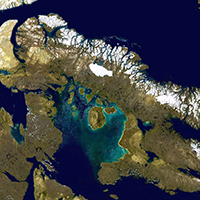Physical and chemical characteristics of 1300 lakes and ponds across the Canadian Arctic
Characteristics of Canadian Arctic lakes and ponds

Accepted: 25 August 2020
Supplementary: 107
HTML: 255
All claims expressed in this article are solely those of the authors and do not necessarily represent those of their affiliated organizations, or those of the publisher, the editors and the reviewers. Any product that may be evaluated in this article or claim that may be made by its manufacturer is not guaranteed or endorsed by the publisher.
Authors
Lakes and ponds are a major feature of the Arctic landscape and are recognized as effective ‘sentinels of change’. Here we present water chemistry characteristics of lakes and ponds (n=1300 with 26 variables) across the Canadian Arctic collated from published studies. We also extracted geological and ecoregion data in an attempt to determine the key drivers. In general, most lakes were shallow (85.4%, <10 m), nutrient (phosphorus) poor (oligotrophic = 45.6% and ultra-oligotrophic = 24.8%), located at low elevation (66.5%, <200 m asl), close to coastlines (72.5%, 0-50 km), and underlain by sedimentary geology (66.5%). The first two components from Principal Component Analysis explained 49.3% of the variation in the dataset; the first component was dominated by conductivity/carbonate materials, and the second component suggested allochthonous inputs of phosphorus. In general, bedrock geology is the primary driver of water chemistry; as such, there were major differences between lakes underlain by igneous and sedimentary rocks. Those on sedimentary bedrock tend to have higher pH, nutrients and higher inorganic ion concentrations.
Edited by
Michela Rogora, CNR-IRSA Verbania, ItalyHow to Cite
Similar Articles
- Markus A. Hoffmann, Alberto Benavent González, Uta Raeder, Arnulf Melzer, Experimental weed control of Najas marina ssp. intermedia and Elodea nuttallii in lakes using biodegradable jute matting , Journal of Limnology: Vol. 72 No. 3 (2013)
- Daniele Paganelli, Renato Sconfietti, Biodiversity loss in a small riverine wetland of the Ticino river (Lombardia, Northern Italy) , Journal of Limnology: Vol. 72 No. 3 (2013)
- Jacek Radzikowski, Anna Sikora, Mirosław Ślusarczyk, The effect of lake sediment on the hatching success of Daphnia ephippial eggs , Journal of Limnology: Vol. 75 No. 3 (2016)
- Eva Pažourková, Josef Křeček, Peter Bitušík, Pavel Chvojka, Lenka Kamasová, Takaaki Senoo, Jan Špaček, Evžen Stuchlík, Impacts of an extreme flood on the ecosystem of a headwater stream , Journal of Limnology: Vol. 80 No. 2 (2021)
- David G. Jenkins, Lakes and rivers as microcosms, version 2.0 , Journal of Limnology: Vol. 73 No. s1 (2014): Limnology in the 21st Century: celebrating 75 years of ecological research in Pallanza
- Pol Tarrats, Miguel Cañedo-Argüelles, Maria Rieradevall, Narcís Prat, Chironomid communities as indicators of local and global changes in an oligotrophic high mountain lake (Enol Lake, Northwestern Spain) , Journal of Limnology: Vol. 76 No. 2 (2017)
- Arpana Yadav, Lalit Kumar Pandey, In situ effects of arsenic, aluminium and chromium stresses on algal periphyton of the river Ganga at Varanasi, India , Journal of Limnology: Vol. 82 (2023)
- Daniela Lupi, Anna Rocco, Bruno Rossaro, Benthic macroinvertebrates in Italian rice fields , Journal of Limnology: Vol. 72 No. 1 (2013)
- Mindaugas Zilius, Rutger de Wit, Marco Bartoli, Response of sedimentary processes to cyanobacteria loading , Journal of Limnology: Vol. 75 No. 2 (2016)
- Sanna T. Korkonen, Antti E.K. Ojala, Emilia Kosonen, Jan Weckström, Seasonality of chrysophyte cyst and diatom assemblages in varved Lake Nautajärvi – implications for palaeolimnological studies , Journal of Limnology: Vol. 76 No. 2 (2017)
<< < 17 18 19 20 21 22 23 24 25 26 > >>
You may also start an advanced similarity search for this article.
-
Jonathan B. Martin, Andrea J. Pain, Ellen E. Martin
-
Zhizhong Li, Madjid Hadioui, Kevin J. WilkinsonNanomaterials : 2023

 https://doi.org/10.4081/jlimnol.2020.1973
https://doi.org/10.4081/jlimnol.2020.1973





